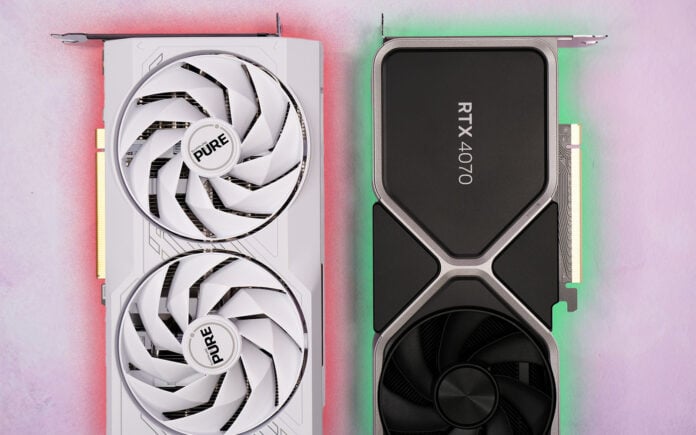We’ve managed to go almost an entire GPU generation with AMD and Nvidia conveniently skirting around one another. GPUs priced to compete directly are few and far between, with each manufacturer typically targeting a gap in the market.
Truth is, it’s a whole lot more fun when both go head-to-head on price, and through an unexpected turn of events, that’s precisely what’s happening in February 2024. Here’s the gist of it. Nvidia, as you may recall, introduced RTX 4070 Super just last month and intentionally lowered RTX 4070 pricing to $549 (£529).
Setting The Stage
Like a game of GPU chess, that delicate move put Team Radeon in a quandary. An RX 7800 XT bishop isn’t strong enough to challenge the GeForce RTX 4070 knight, so how does AMD go about filling that huge gap below its top pairing of king and queen?
| GPU | RX 7900 XT | RX 7900 GRE | RX 7800 XT | RTX 4070 Super | RTX 4070 | RTX 4060 Ti |
|---|---|---|---|---|---|---|
| Launch date | Dec 2022 | Jul 2023* | Sep 2023 | Jan 2024 | Apr 2023 | May 2023 |
| Codename | Navi 31 | Navi 31 | Navi 32 | AD104 | AD104 | AD106 |
| Architecture | RDNA 3 | RDNA 3 | RDNA 3 | Ada | Ada | Ada |
| Process (nm) | 5/6 | 5/6 | 5/6 | 4 | 4 | 4 |
| Transistors (bn) | 57.7 | 57.7 | 28.1 | 35.8 | 35.8 | 22.8 |
| Die size (mm2) | 522 | 522 | 350 | 294.5 | 294.5 | 187.8 |
| Compute units | 84 of 96 | 80 of 96 | 60 of 60 | 56 of 60 | 46 of 60 | 34 of 36 |
| Shaders | 5,376 | 5,120 | 3,840 | 7,168 | 5,888 | 4,352 |
| Boost clock (MHz) | 2,400 | 2,245 | 2,430 | 2,475 | 2,475 | 2,535 |
| Peak FP32 TFLOPS | 51.61 | 45.98 | 37.32 | 36 | 29.1 | 22.1 |
| RT cores | 84 | 80 | 60 | 56 | 46 | 34 |
| AI / Tensor cores | 168 | 160 | 120 | 224 | 184 | 136 |
| ROPs | 192 | 192 | 96 | 80 | 64 | 48 |
| Infinity / L2 Cache (MB) | 80 | 64 | 64 | 48 | 36 | 32 |
| Memory size (GB) | 20 | 16 | 16 | 12 | 12 | 8 |
| Memory type | GDDR6 | GDDR6 | GDDR6 | GDDR6X | GDDR6X | GDDR6 |
| Memory bus (bits) | 320 | 256 | 256 | 192 | 192 | 128 |
| Memory clock (Gbps) | 20 | 18 | 19.5 | 21 | 21 | 18 |
| Bandwidth (GB/s) | 800 | 576 | 624 | 504 | 504 | 288 |
| PCIe interface | 4.0 x16 | 4.0 x16 | 4.0 x16 | 4.0 x16 | 4.0 x16 | 4.0 x8 |
| Power (watts) | 315 | 260 | 263 | 220 | 200 | 160 |
| MSRP ($) | 899 | 549 | 499 | 599 | 549 | 399 |
The answer is Radeon RX 7900 GRE, now available globally. What the heck is a GRE, might you ask? The suffix is new and stems from the card launching as a China exclusive back in July 2023. Stands for ‘Golden Rabbit Edition,’ a nod to the Chinese zodiac calendar. Curious it isn’t rebranded for the global rollout, or even updated for 2024. Dragon Edition just sounds much better.
Why was this intriguing addition a China exclusive to begin with? Club386 posed that question to AMD and had the following response:
Originally, the Radeon RX 7900 GRE graphics card was specifically designed to meet the unique market and customer requirements in that particular region (Mainland China). With the changing competitive landscape of the GPU market, it was the right time to bring the Radeon RX 7900 GRE to global markets.
Look past the name and it’s an interesting addition for many reasons, with some good and some bad. AMD essentially takes its lowest-binned Navi 31 die, presenting 80 of 96 available Compute Units. A near-5% reduction in shaders over 7900 XT sounds more than acceptable given the gulf in price, but there are more savage cuts elsewhere.
On the back end, memory size, bus width and clock have all been cleaved, leaving 16GB of VRAM and 576GB/s bandwidth. A whopping 28% reduction compared to the next GPU up, and the eagle eyed among you will note that bandwidth is in fact lower than RX 7800 XT. Top heavy, to say the least.
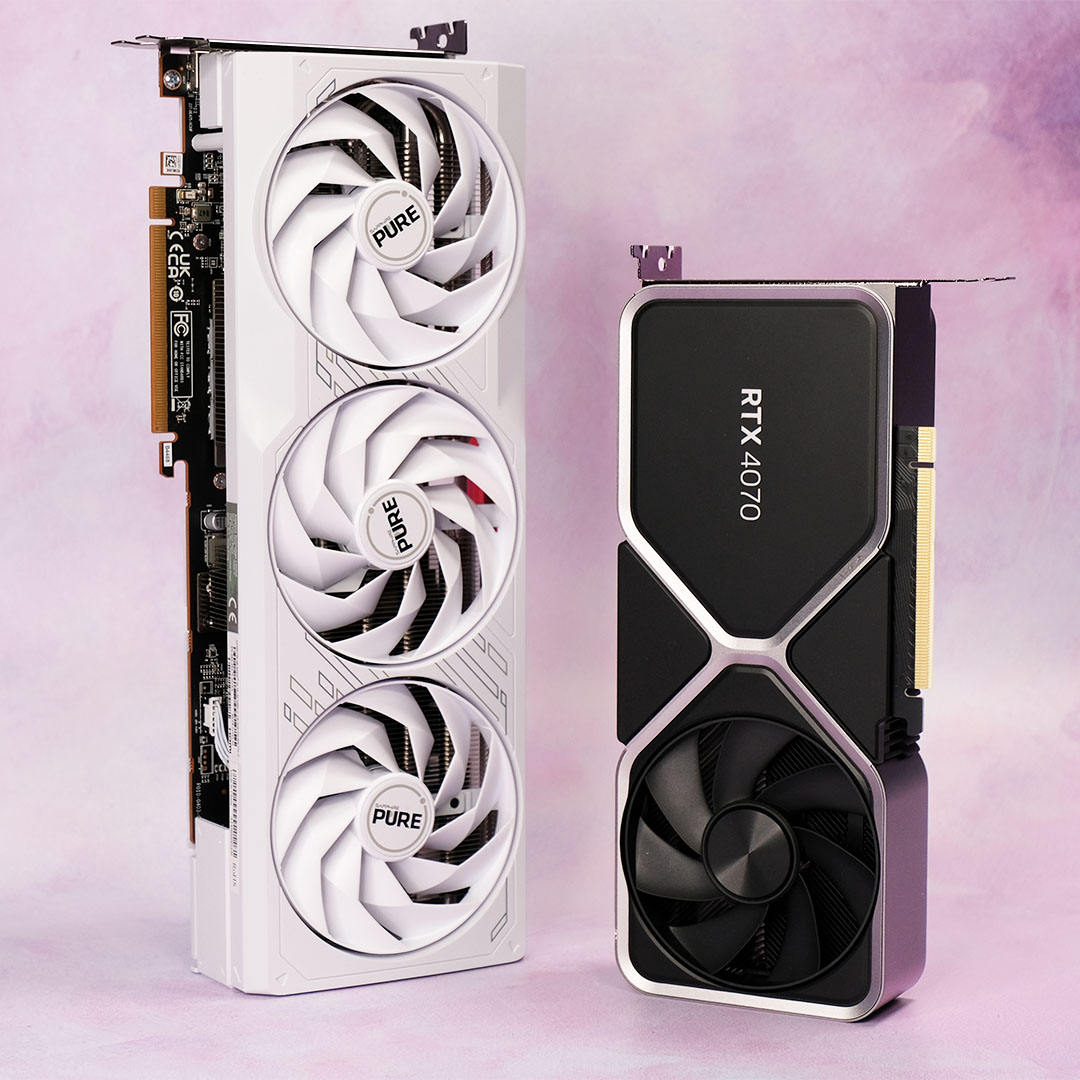
Still, you’ve got to get to $549 somehow or other. What’s fascinating is the contrasting approach between competitors. While GeForce RTX 4070 is a lean 294.5mm2 part efficiently rated at 200W, rival Radeon RX 7900 GRE is a 522mm2 behemoth pulling 260W.
You wouldn’t expect to see a GPU almost twice the size competing at the same price point, but here we are, and from a fabrication perspective, Team Green is in a much comfier spot.
Sapphire Pure vs. Founders Edition
Another point of variation is in model availability. While RTX 4070 can be purchased in a choice of Founders Edition or partner designs, RX 7900 GRE is available only from partners; there is no MBA (Made by AMD).
No bad thing as Sapphire, one of our best-rated AIBs, is quick out the gate with a choice of three models. Pulse starts at $549, Pure fetches $569 and Nitro+ will set you back $599. Between you and me, while Nitro+ is insanely pretty, price is all-important in this segment.
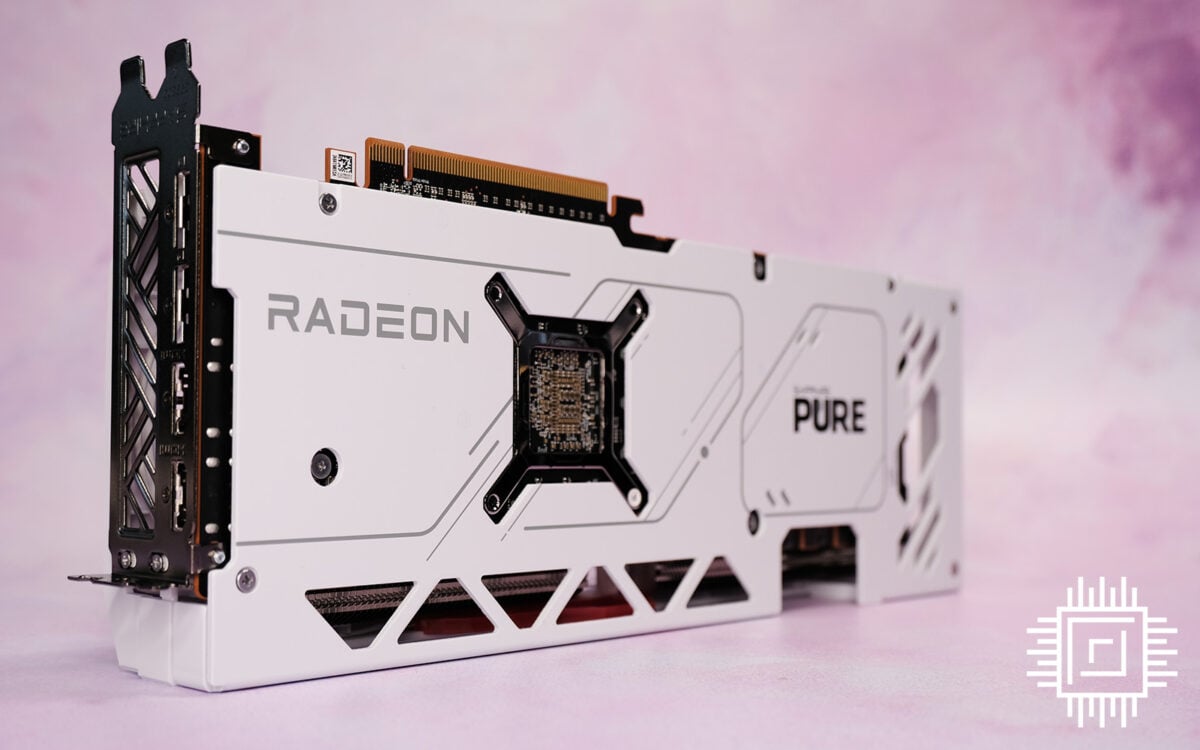
We’ve got our hands on the Pure RX 7900 GRE for today’s comparison, and it’s a lovely card for a frosty-white build. Sapphire does the right thing by including a full-metal backplate as standard to complete the aesthetic. Other niceties include a 14-layer, 2oz copper PCB, plus 14-phase digital power delivery, and with a trio of fans, there’s going to be no difficulty in keeping the underlying GPU running cool at all times.
The obvious caveat is one of chassis compatibility. Nvidia GeForce RTX 4070 Founders Edition is a dual-slot solution measuring 244mm x 112mm. Sapphire Pure Radeon RX 7900 GRE, meanwhile, is a triple-slot beastie extending to 320mm in length and a chunky 129mm wide. Phat, you could say.
All three of Sapphire’s custom cards are also factory overclocked as standard. Pulse climbs to a boost clock of 2,293Hz, Pure chimes in at 2,333MHz, while Nitro+ leads the pack at 2,391MHz. Do be aware that total board power rises in tandem to 268W, 275W and 295W, respectively.
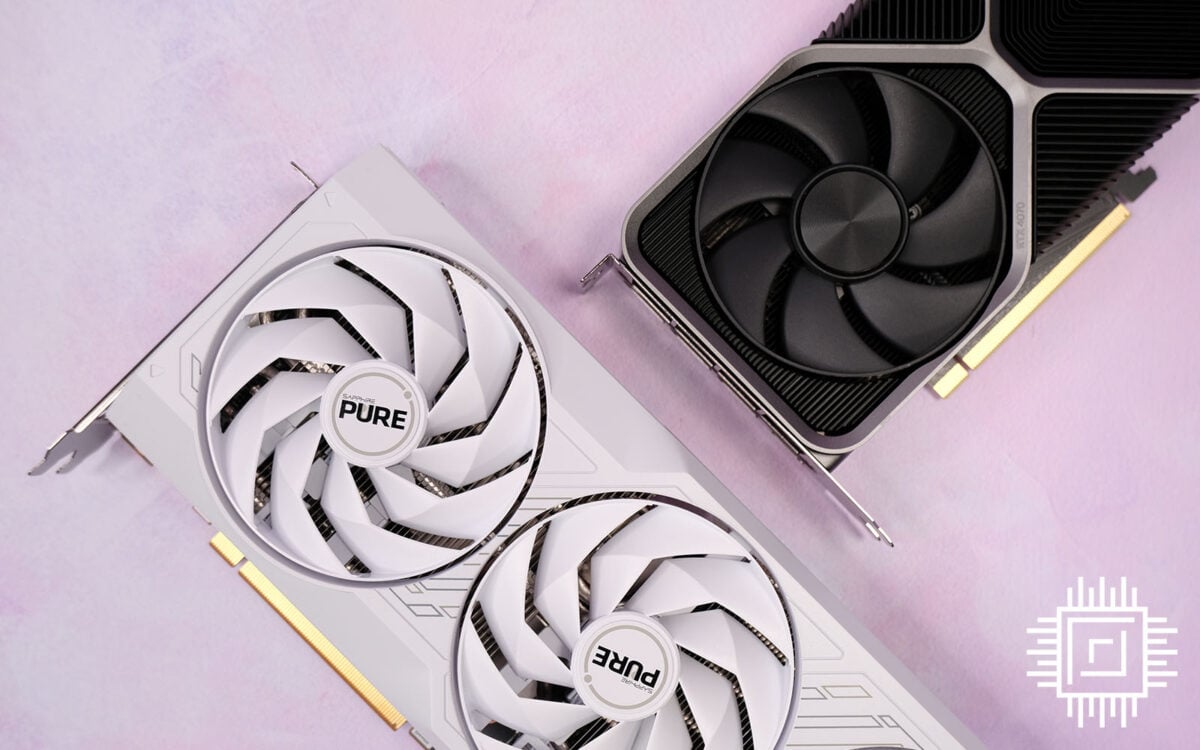
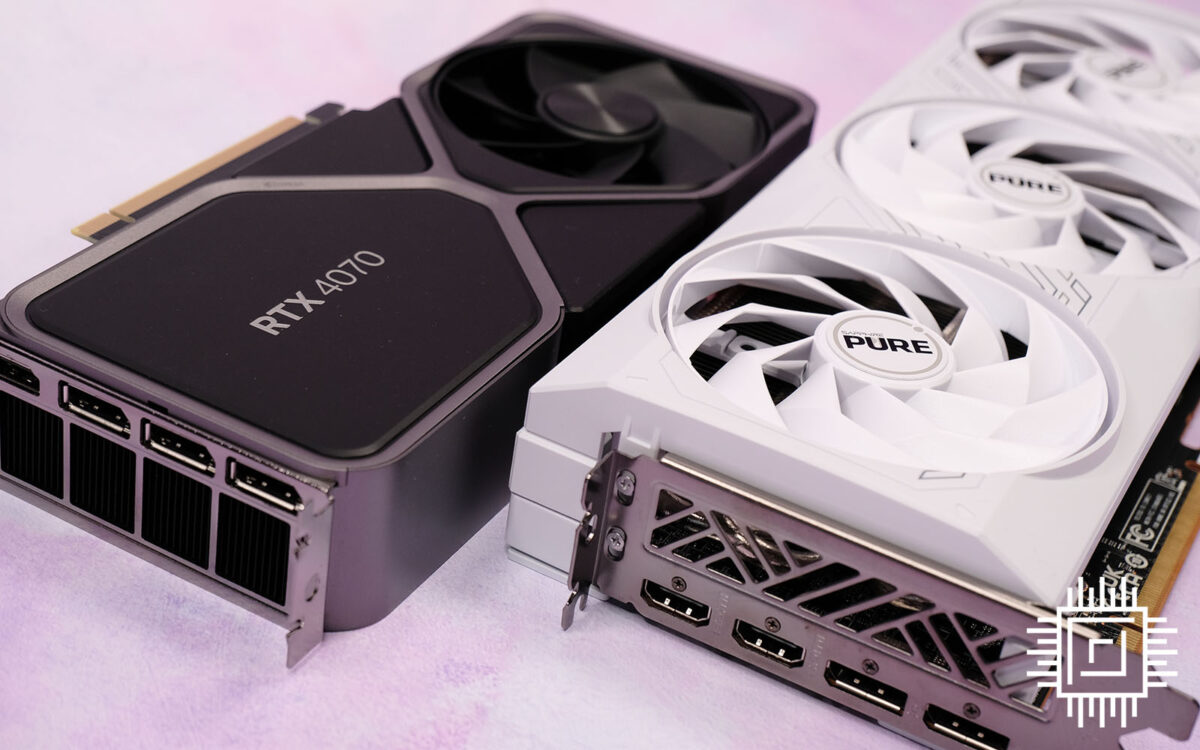
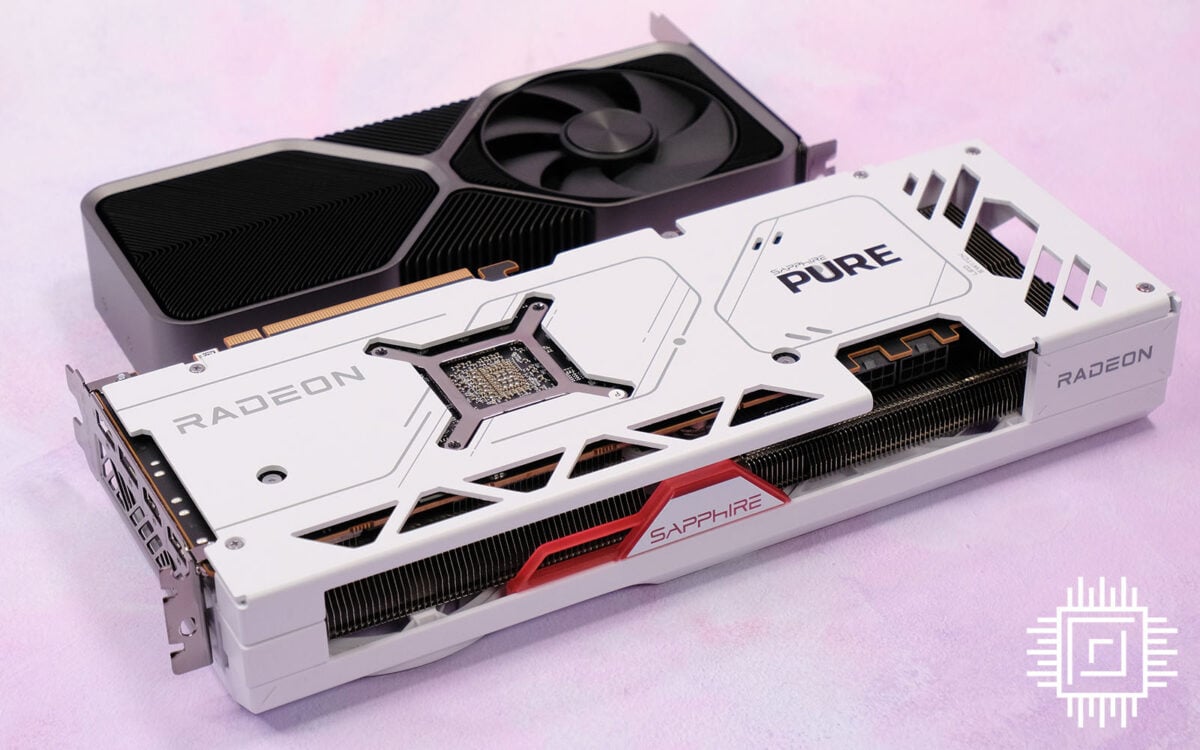
It’s a matter of the dark side or the light, and as you’ll see in the benchmarks, picking one over the other is very much a personal preference. Building small form factor? The GeForce is the obvious choice. Want to keep noise levels down to a minimum? Go for the Sapphire. Nvidia’s card affords you a trio of DisplayPort 1.4 and a single HDMI 2.1, while the AMD is better equipped with two HDMI 2.1 and two DisplayPort 2.1.
There are few red flags on either front, but there is an alarming red LED to be aware of. See the Sapphire logo adorning the top edge of the card? It’s backlit in a gaudy red that detracts from the otherwise sleek aesthetic. The colour can’t be changed, but there is a thankfully a dedicated hardware switch to toggle the lighting off.
These are minor points and, ultimately, the decision boils down to performance. Without further ado, let’s run the benchmarks.
Performance
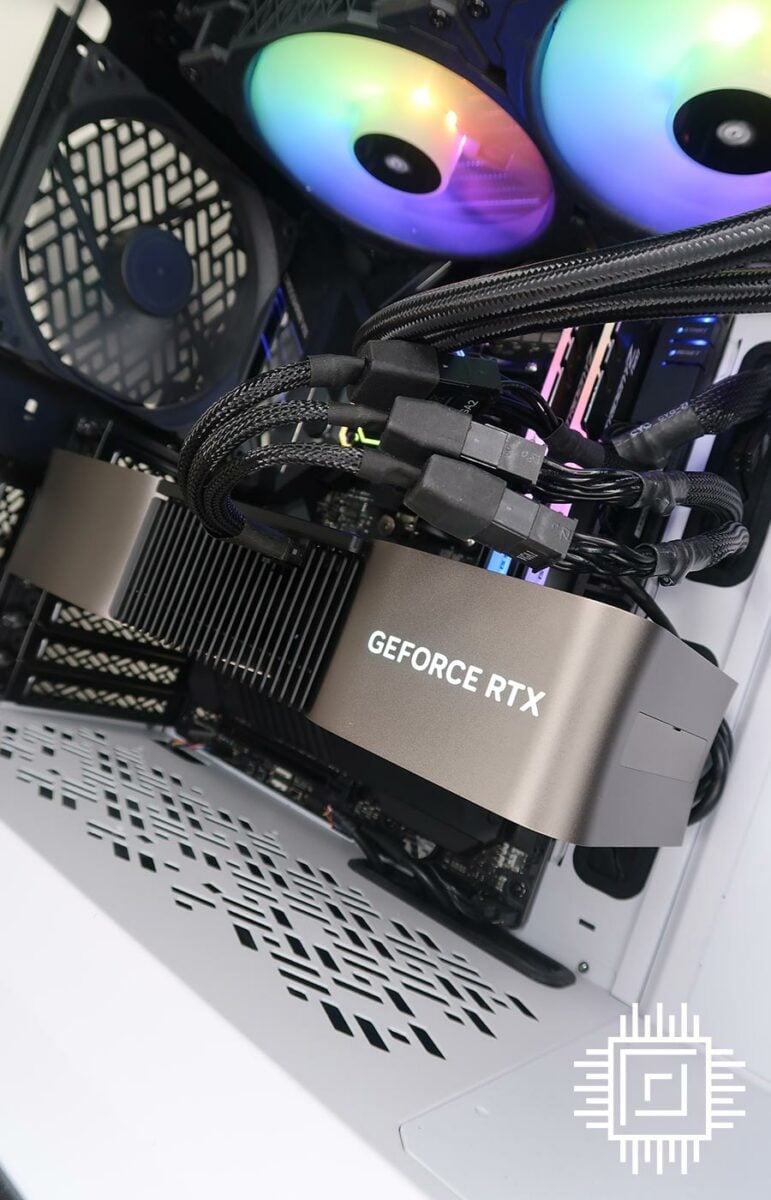
Our 5950X Test PCs
Club386 carefully chooses each component in a test bench to best suit the review at hand. When you view our benchmarks, you’re not just getting an opinion, but the results of rigorous testing carried out using hardware we trust.
Shop Club386 test platform components:
CPU: AMD Ryzen 9 5950X
Motherboard: Asus ROG X570 Crosshair VIII Formula
Cooler: Corsair Hydro Series H150i Pro RGB
GPU: Sapphire Nitro+ Radeon RX 5700 XT
Memory: 32GB G.Skill Trident Z Neo DDR4
Storage: 2TB Corsair MP600 SSD
PSU: be quiet! Straight Power 11 Platinum 1300W
Chassis: Fractal Design Define 7 Clear TG
Both Radeon RX 7900 GRE and GeForce RTX 4070 have been tested afresh with the latest available drivers, Adrenalin Edition 24.2.1 and GeForce Game Ready 551.61, respectively.
3DMark

Tried-and-trusted Time Spy gets us underway, and there’s no doubt about it, in the rasterisation stakes the Radeon strikes an early blow. Nearly 15% quicker at the QHD resolution is a healthy lead.

Crank the resolution to 4K via Time Spy Extreme and the advantage extends to 17%. The upside to more VRAM becomes apparent as pixel count increases.

There’s more to graphics these days than pure rasterisation. Speed Way, one of 3DMark’s latest synthetic benchmarks, is a DirectX 12 Ultimate test that includes real-time raytraced reflections and global illumination. In this scenario, however, the tables turn, with the GeForce eking out a small lead.

AMD has made progress in the raytracing department, but Nvidia continues to hold a healthy lead in this dedicated 3DMark test.

Radeon has the upper hand in rasterisation and, as expected, GeForce leads the way in raytracing and shader efficiency.
Gaming
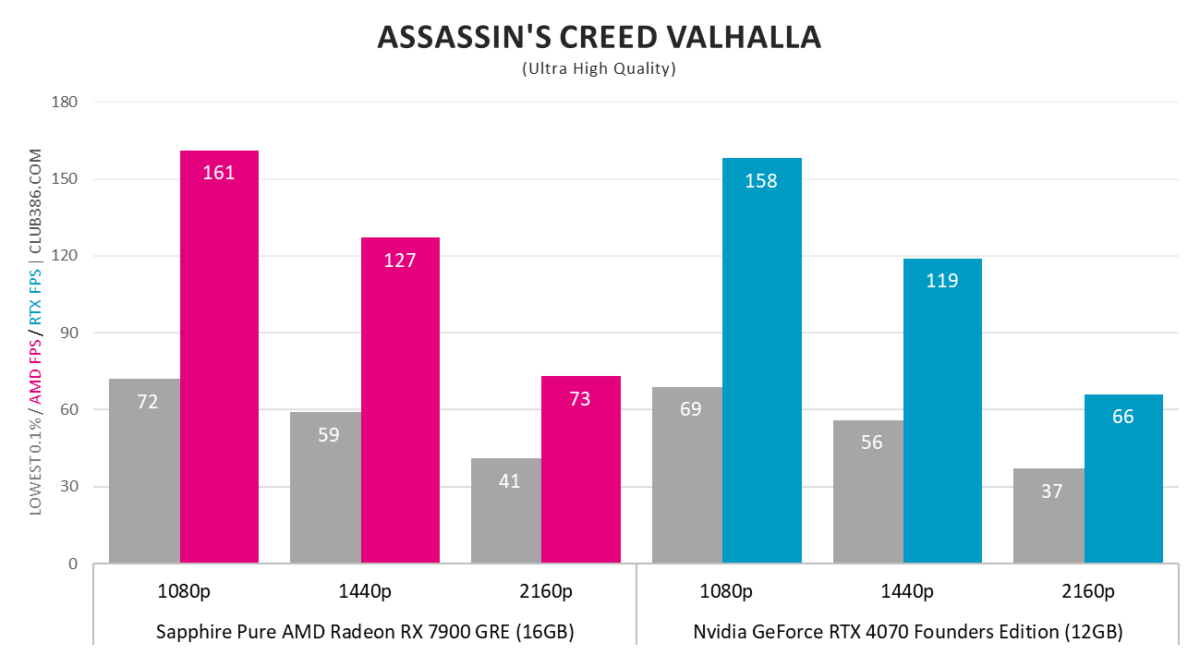
In terms of real-world gaming, it’s a closely fought contest in Assassin’s Creed Valhalla. The two GPUs are indistinguishable at 1080p, but the 16GB Radeon races ahead at higher resolutions. A 2% gap at 1080p FHD grows to 7% at 1440p QHD and 11% at 4K UHD.
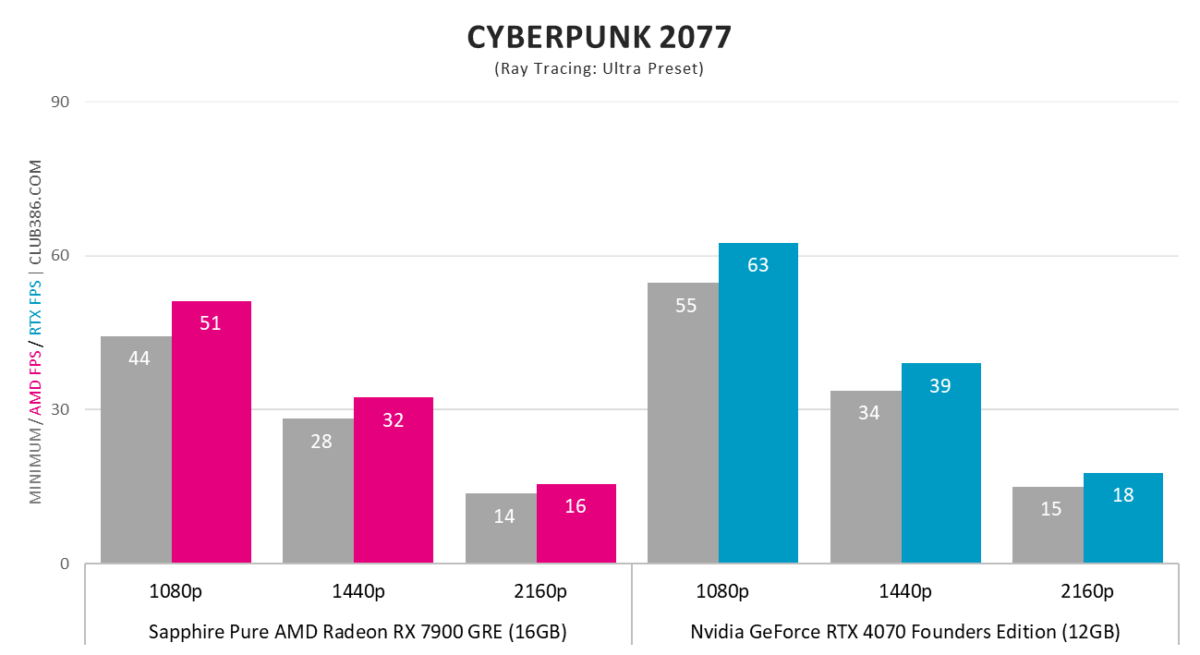
As always, the game you play can heavily influence the graphics card you need to buy. Cyberpunk 2077 looks best with copious amounts of raytracing, and though the GeForce is better in this regard, neither card can deliver silky framerates at QHD. For that you’ll need Fluid Motion Frames or DLSS Frame Generation. More on that later.
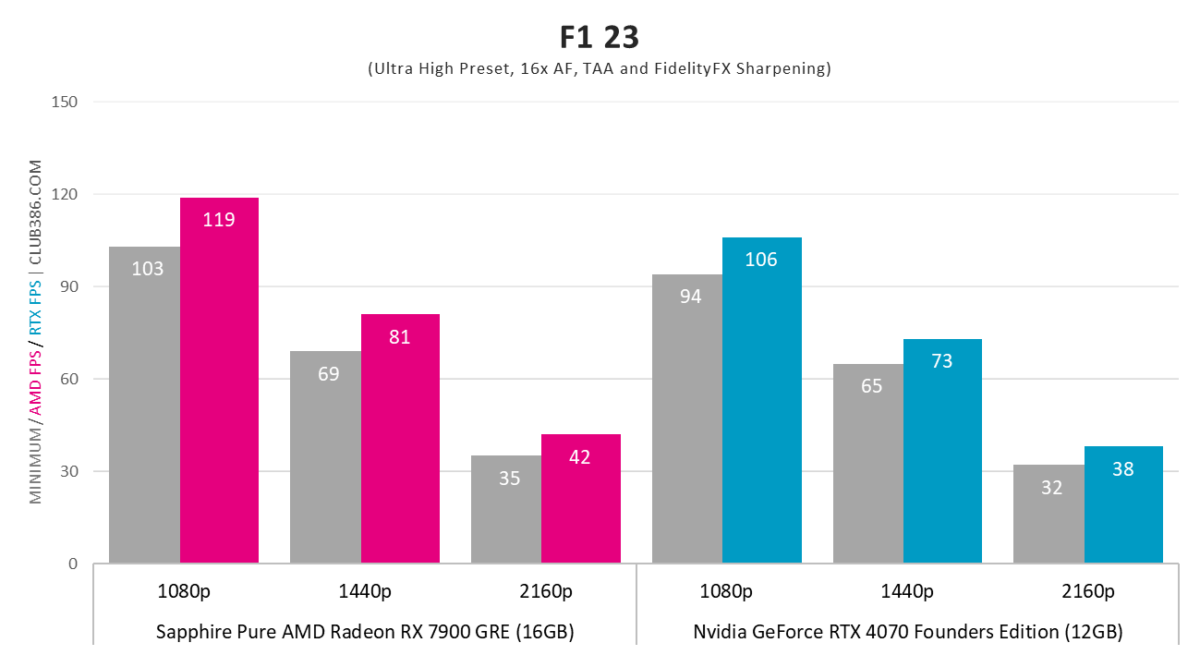
Either card can deliver over 60 frames per second at QHD here, but the latest F1 racer does favour AMD hardware.
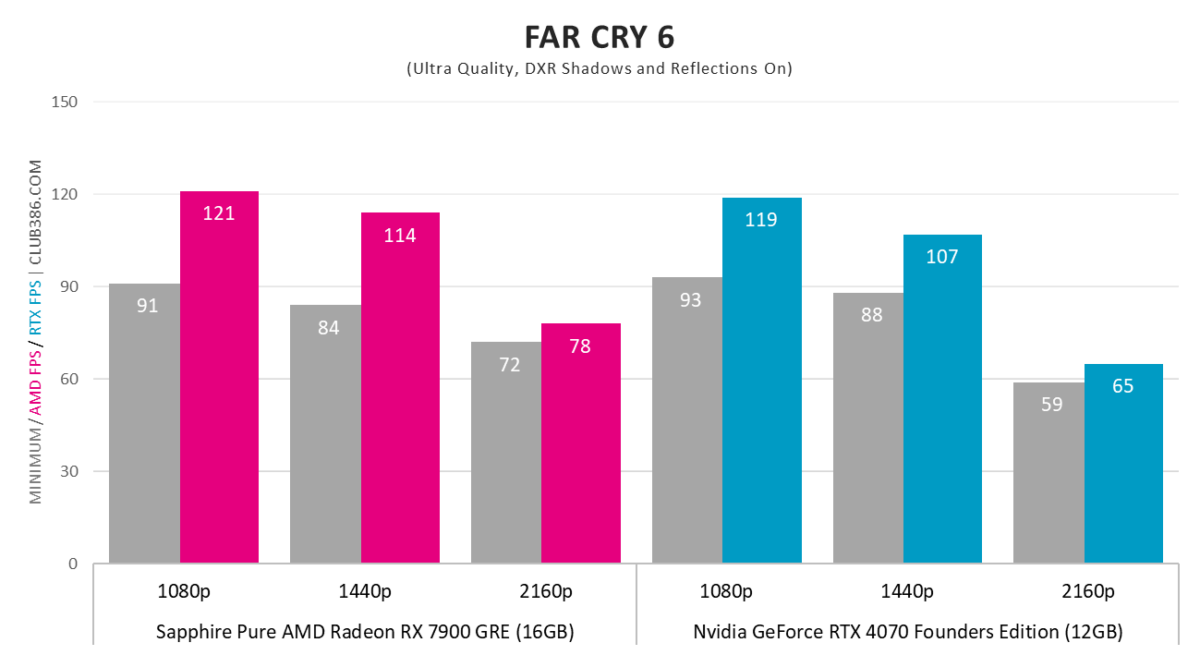
Even with raytracing enabled, it’s the Radeon leading the charge in Far Cry 6. To be fair, both cards are evenly matched at 1080p, but as has been the trend thus far, RX 7900 GRE’s larger memory pool pays dividends at higher resolutions.
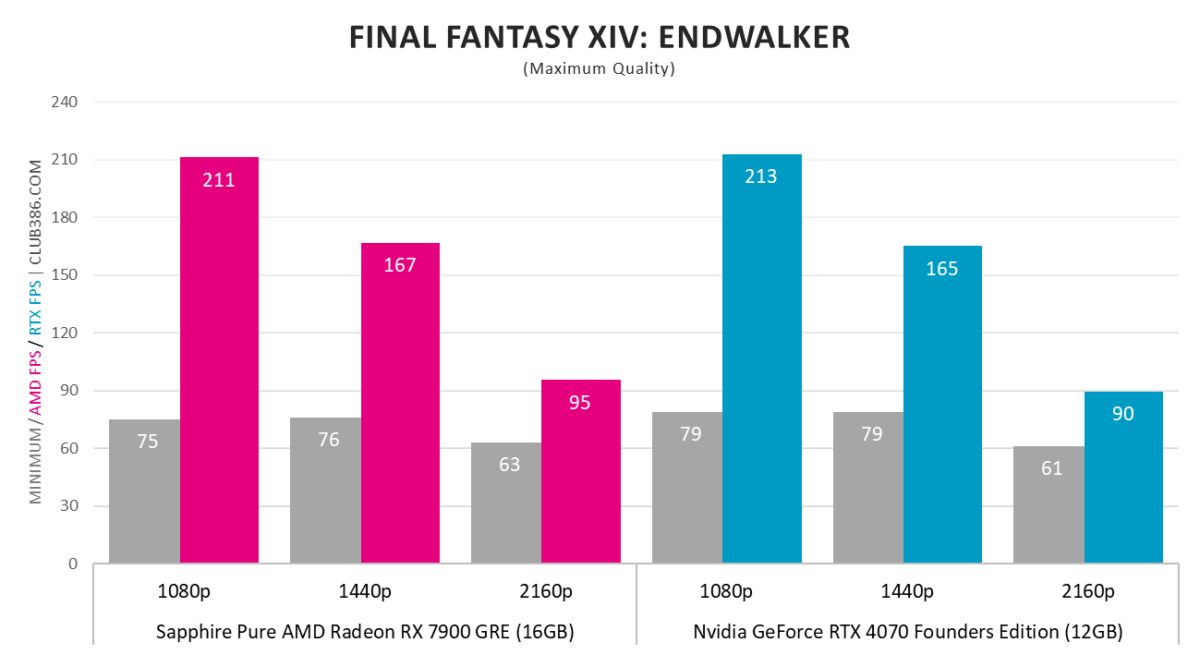
Some games will show performance variance, others won’t. In Final Fantasy both cards deliver excellent results.
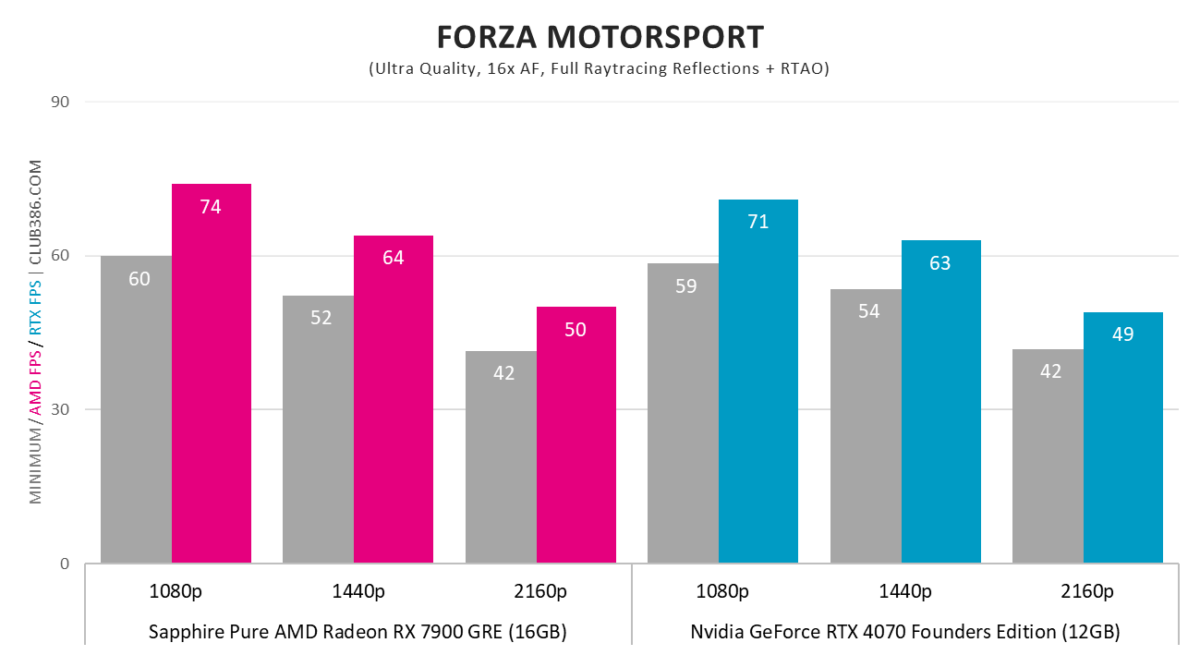
A slew of patches are turning Forza Motorsport into the game it should have been at launch. It looks terrific with full raytracing enabled and can be quite demanding. Once again, both cards are ideal when paired to a 2560×1440 screen.
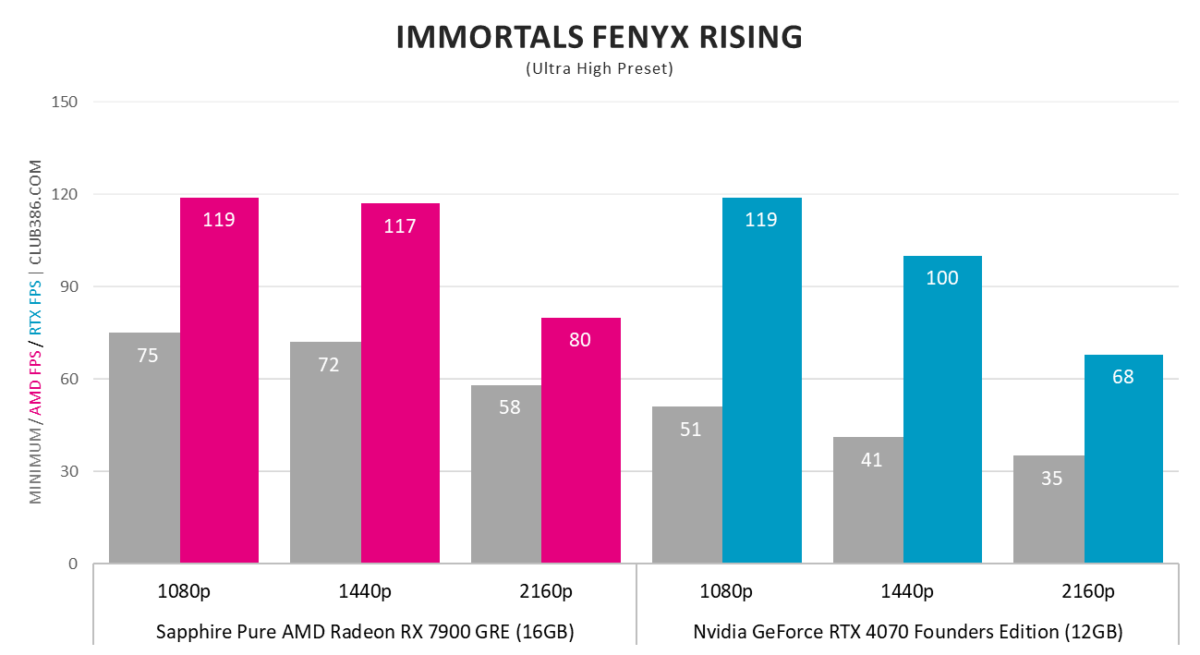
A pattern is developing. Once again the Radeon moves clear at the two higher resolutions.
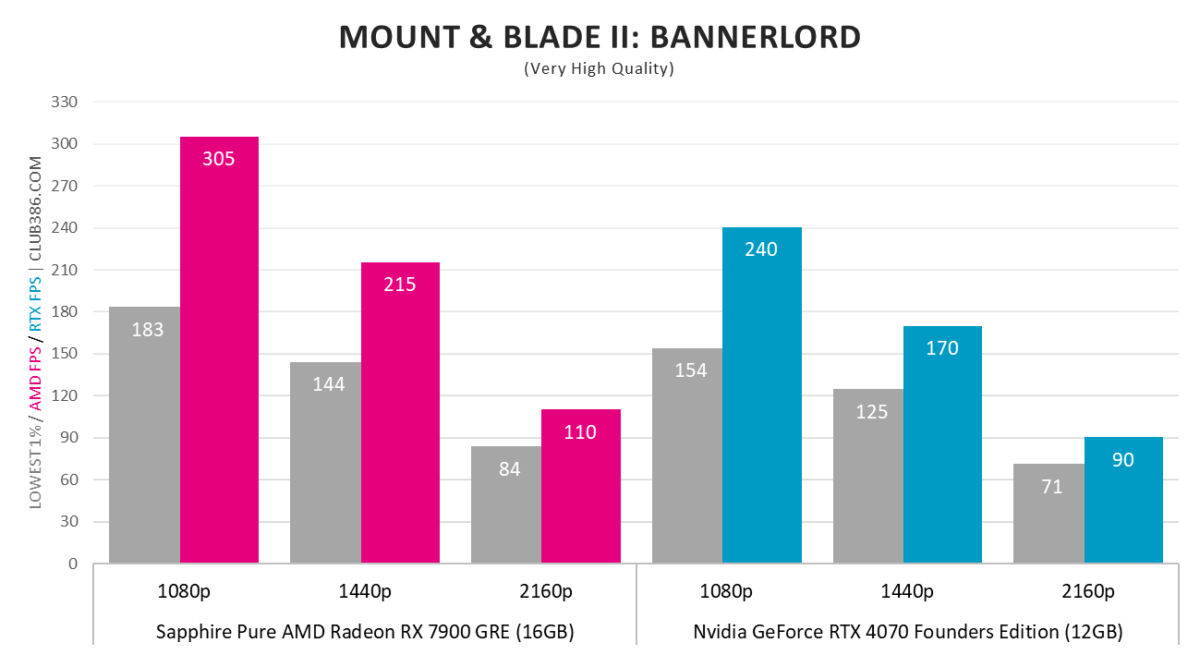
Bannerlord takes as much raw rasterisation as you can throw at it. No wonder the sheer grunt of the Radeon is so impressive in this title.
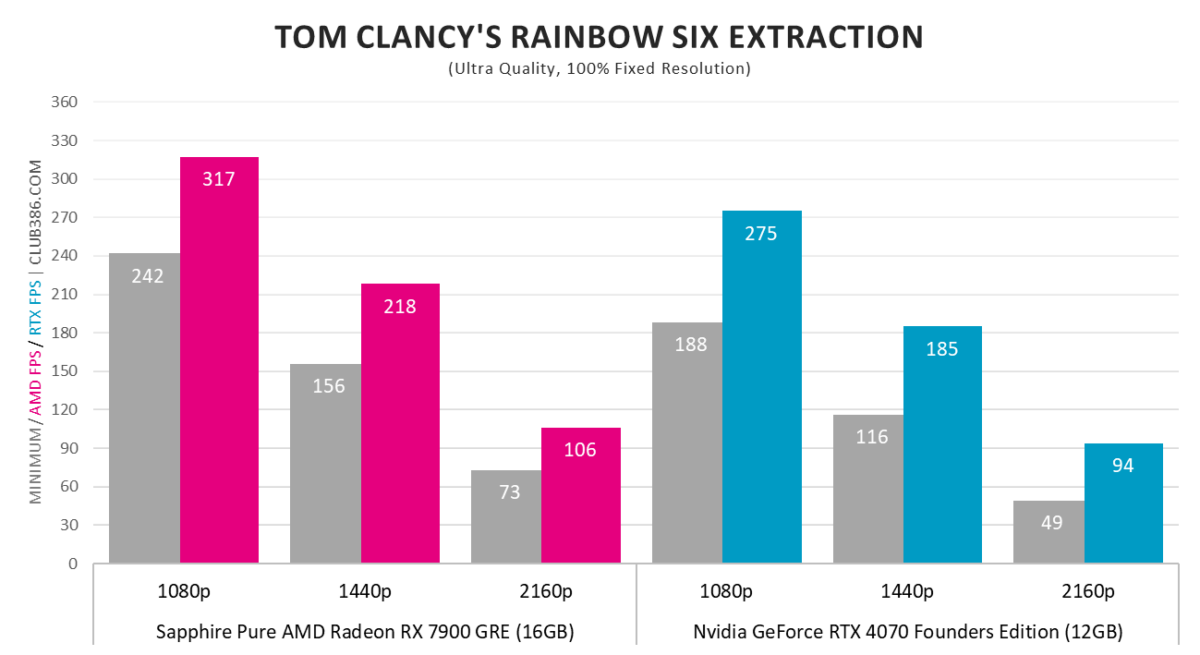
It’s another clean sweep for the 7900 GRE here. A clear winner for many of today’s games, but what about tomorrow?
AFMF vs. DLSS
To see what the future holds, it is instructive to examine each brand’s interpretation of forward-looking technologies such as AI upscaling and frame generation. The toughest game to render, Cyberpunk 2077, is re-benched with comparable settings to evaluate the potential of each card. For RX 7900 GRE that entails FSR upscaling set to ‘Quality’ and Fluid Motion Frames enabled. RTX 4070, meanwhile, runs DLSS set to Quality with Frame Generation turned on.
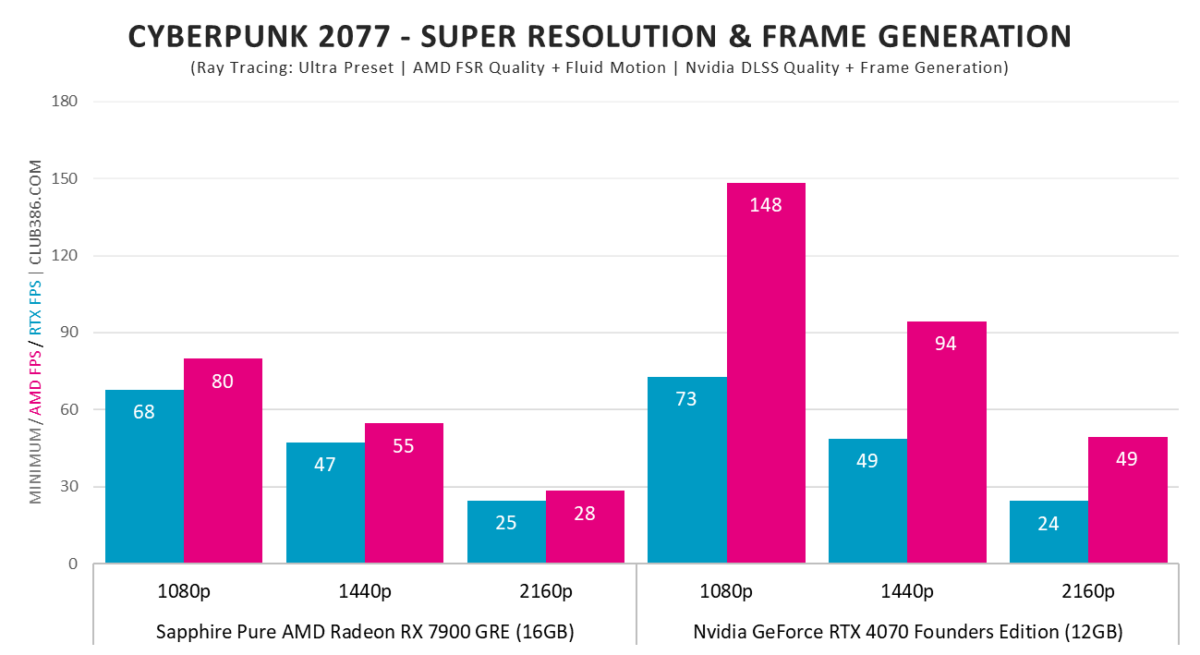
It’s not a close contest. The wizardry of DLSS 3 is a meaningful feather in the GeForce cap. Performance is not only miles ahead, but the experience is superior, with fewer artefacts and less lag. AMD is still playing catchup here.
Efficiency

We alluded to GeForce efficiency earlier in the review, and here’s the proof. System-wide power draw is nearly 12% lower when gaming. Something to consider if you have one eye on the ‘leccy bill.

Neither card has any difficulty keeping chill under full load. Curiously, though, it’s the much smaller GeForce that runs a fraction cooler.

Lower temps can be attributed to the Founders Edition running its fans a little bit harder. RTX 4070 is by no means loud, but the Sapphire Pure RX 7900 GRE is eerily quiet.
Value
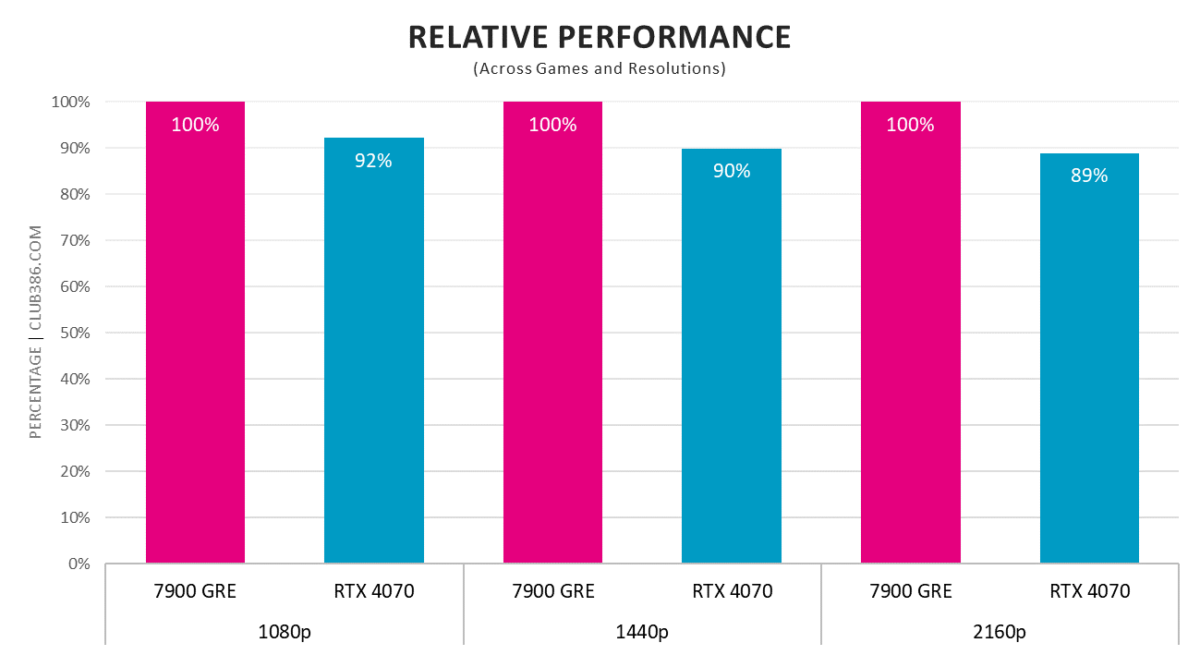
Total framerate across all tested titles confirms our findings thus far. RTX 4070 offers, on average, 92% of RX 7900 GRE’s performance at 1080p. That figure drops to 90% at 1440p at 89% at 2160p.
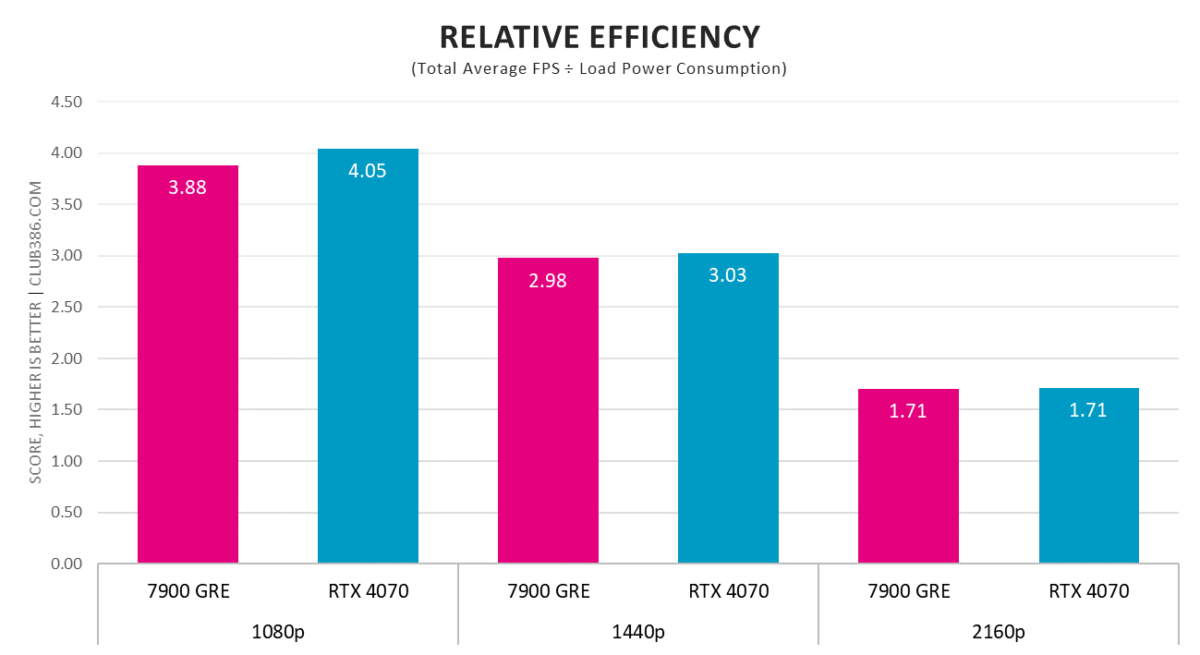
Dividing total framerate by in-game power consumption reiterates Nvidia’s advantage in the efficiency stakes.
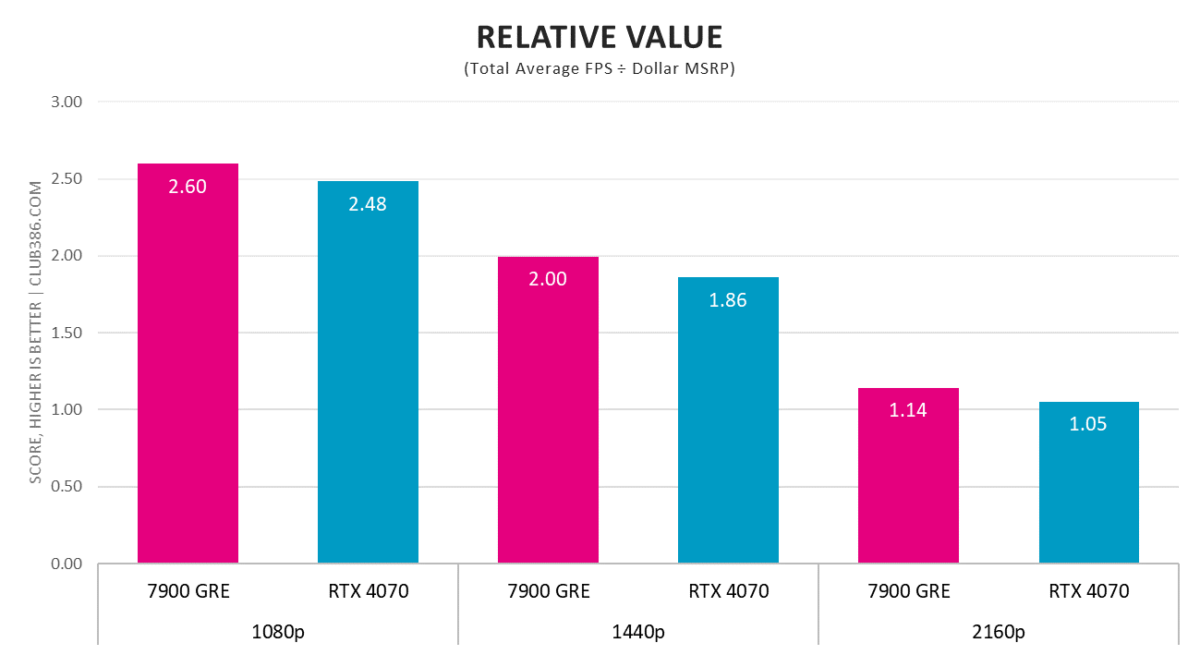
Rounding out the metrics, we divide total average FPS by the dollar MSRP. That’s $549 for the GeForce RTX 4070 Founders Edition and $569 for the Sapphire Pure RX 7900 GRE. Even with the slight premium, the Radeon nabs a win as the better value proposition.
Conclusion
The mid-range landscape has been starved of genuine competition for too long. Radeon RX 7900 GRE helps restore a semblance of normality by delivering a viable alternative to Nvidia’s existing GeForce RTX 4070.
Neither will set hearts racing as a $549 / £529 price tag remains somewhat steep in the aftermath of a hugely inflated market. Nevertheless, these are competent cards and welcome upgrade paths for those who’ve played the waiting game.
Keeping to their respective strengths, AMD’s Radeon goes hard on rasterisation and delivers enough memory to cope with the real demands of high-resolution gaming. Nvidia’s GeForce puts the emphasis on efficiency and forward-looking technologies such as raytracing and frame generation.
We’re of the opinion there’s no bad option here, but if we absolutely had to pick a $549 graphics card, the 16GB Radeon RX 7900 GRE gets the nod.
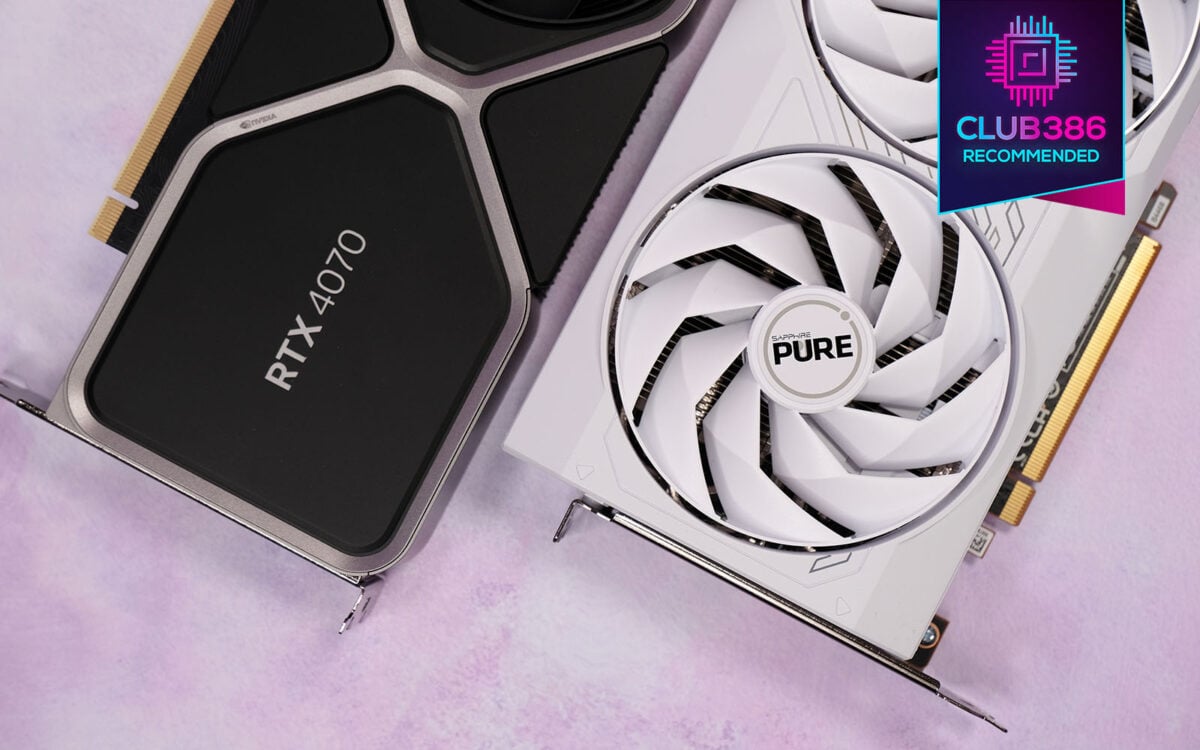
Nvidia GeForce RTX 4070
Founders Edition
Verdict: a fine showcase of what a small, efficient, and forward-looking GPU can do.
Pros
Excellent efficiency
Small and elegant
Great for 1440p
DLSS 3 is magic
Cons
Only 12GB memory
Lacks raster firepower
Sapphire Pure Radeon
RX 7900 GRE
Verdict: brings welcome competition to the mid-range and renders RX 7800 XT moot.
Pros
Packs a raster punch
Great for 1440p
16GB memory
Runs very quiet
Cons
Middling raytracing
FSR playing catchup

